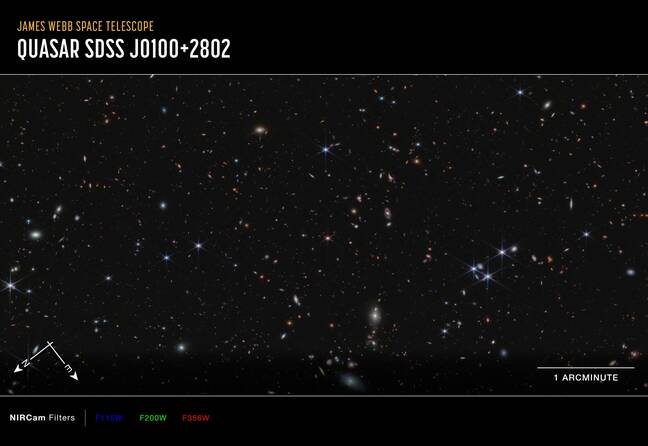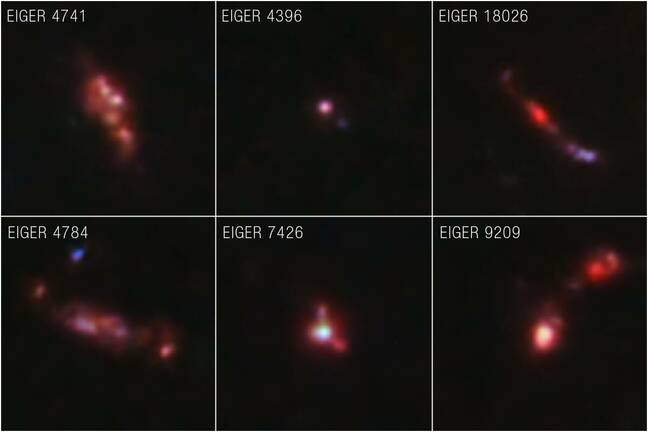James Webb spots the early galaxies responsible for tidying up the universe
I can see clearly now reionization's done
If you didn't already know, it may surprise you to discover that space wasn't always clear.
Quite the opposite, in fact. Space – or at least the gas between stars and galaxies – was opaque in the early days of the universe. The gas later became transparent and energetic starlight could then penetrate it. Thanks to the James Webb Space Telescope, we now know why.
An international team, led by ETH Zürich's Simon Lilly, working on the Emission-line galaxies and Intergalactic Gas in the Epoch of Reionization (EIGER) project made the determination in a series of papers that early galaxies were responsible for ionizing interstellar gas after they pointed Webb at a quasar estimated to have formed some 900 million years after the Big Bang during the period of reionization.
By looking at the light from the quasar as it traveled 12.8 billion light-years through space to reach Earth, and pairing those observations with data from other telescopes like the WM Keck Observatory in Hawaii and Europe's Very Large Telescope in Chile, the team was able to spot bubbles of clearer space around early galaxies.
"The researchers then used Webb to identify galaxies near this line of sight and showed that the galaxies are generally surrounded by transparent regions about 2 million light-years in radius. In other words, Webb witnessed galaxies in the process of clearing the space around them," NASA said.
Those massive clear areas of space, said the team, are roughly comparable to a galaxy the size of a pea suspended inside a hot air balloon. To put that in less El Reg unit terms, NASA said the radius of space each galaxy ionized was around the same distance between the Milky Way and our nearest galactic neighbor, Andromeda.
"Not only does Webb clearly show that these transparent regions are found around galaxies, we've also measured how large they are," said Daichi Kashino of Nagoya University in Japan, lead author of the EIGER team's first paper.
- James Webb smells someone having barbecue in galaxy 12 billion light years away
- Astronomers spot Earth-sized exoplanet probably 'carpeted' by volcanoes
- Astronomers say they've seen the largest explosion yet – and we just had to talk to them
- Star Fomalhaut has dusty little secret – two more debris belts and a potential planetary party
The era of reionization is estimated to have lasted for around 600 million years, ending approximately one billion years after the Big Bang, or approximately 13 billion years ago.
Ionization began as the first stars and galaxies began forming, heating the cooled, dense, opaque and light-absorbing gas that filled the universe. As those galaxies formed, their ionization bubbles grew, eventually merging to form our modern transparent universe – assuming, of course, there aren't dark, deep non-ionized corners of the universe out there somewhere.
Also discovered: A new largest observed black hole
While it was looking for evidence for the cause of reionization, the EIGER team was also able to use data gathered from the JWST to find a new honoree for the "most massive black hole in the known universe" award. The supermassive black hole at the center of the quasar the EIGER team observed was determined [PDF] to weigh 10 billion times the mass of the Sun, something researchers said is challenging to explain with current black hole formation models and our understanding of the time needed for their formation.
For every mystery it shines a light on, the JWST seems to expose more unknowns, said EIGER project member Anna-Christina Eilers of MIT, lead author on another of the team's papers. "We still can't explain how quasars were able to grow so large so early in the history of the universe. That's another puzzle to solve!"
The EIGER team has five additional observational fields to examine for their project, but according to NASA they couldn't wait to share the results from their first batch of observations. "We expected to identify a few dozen galaxies that existed during the Era of Reionization – but were easily able to pick out 117," Kashino noted. "Webb has exceeded our expectations." ®


 Biting the hand that feeds IT
Biting the hand that feeds IT